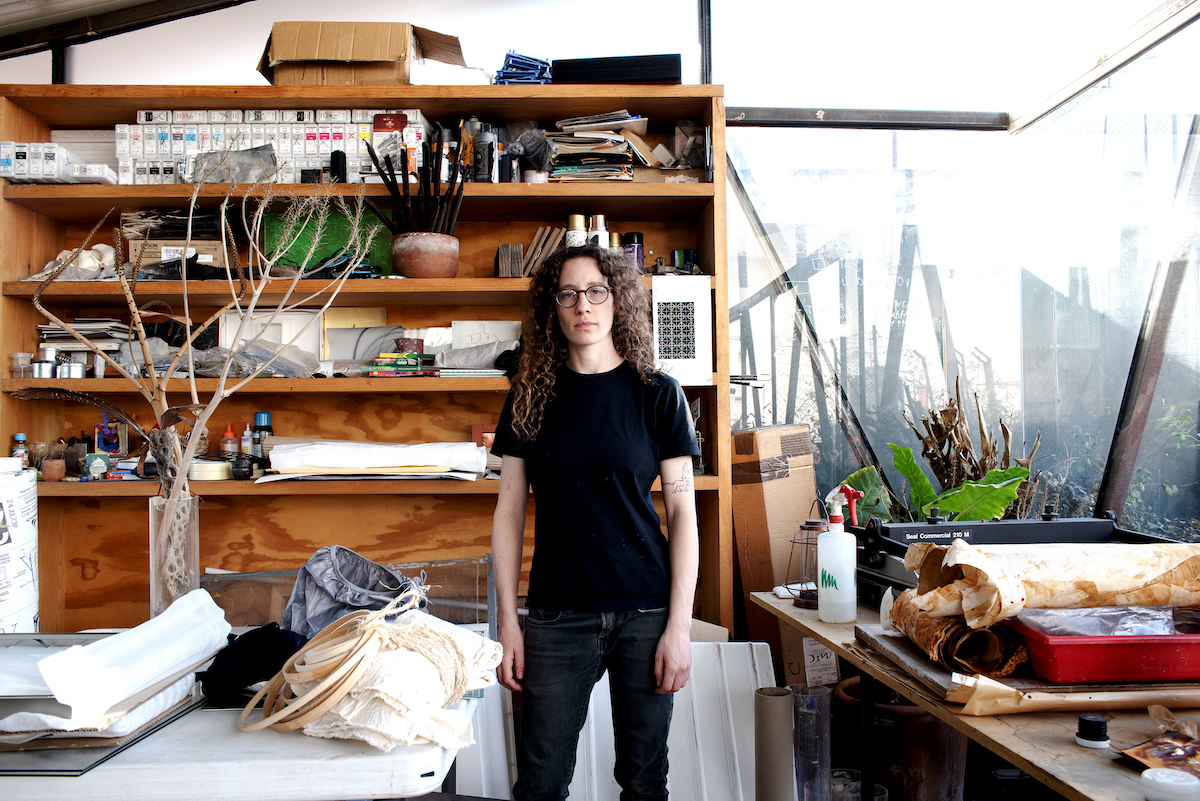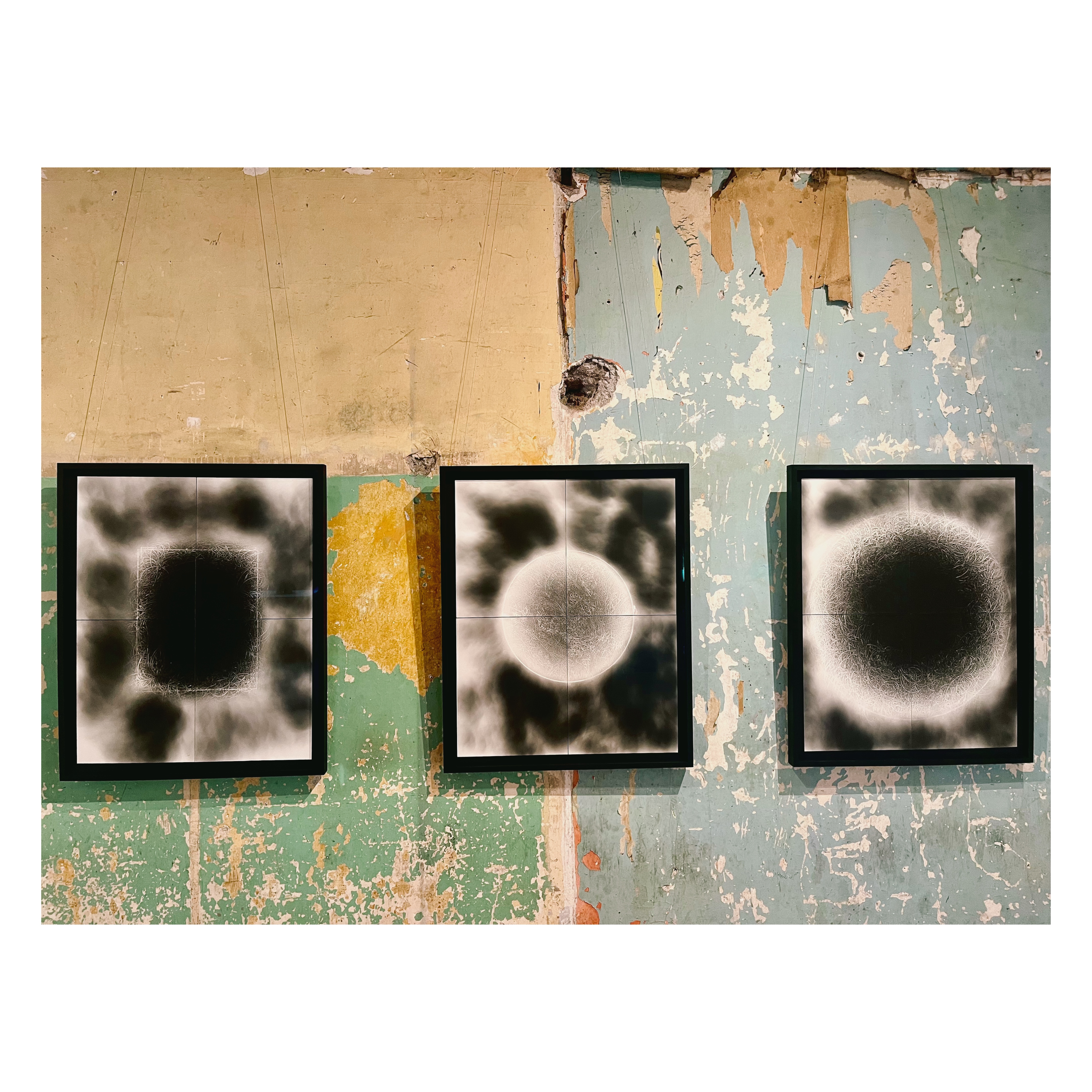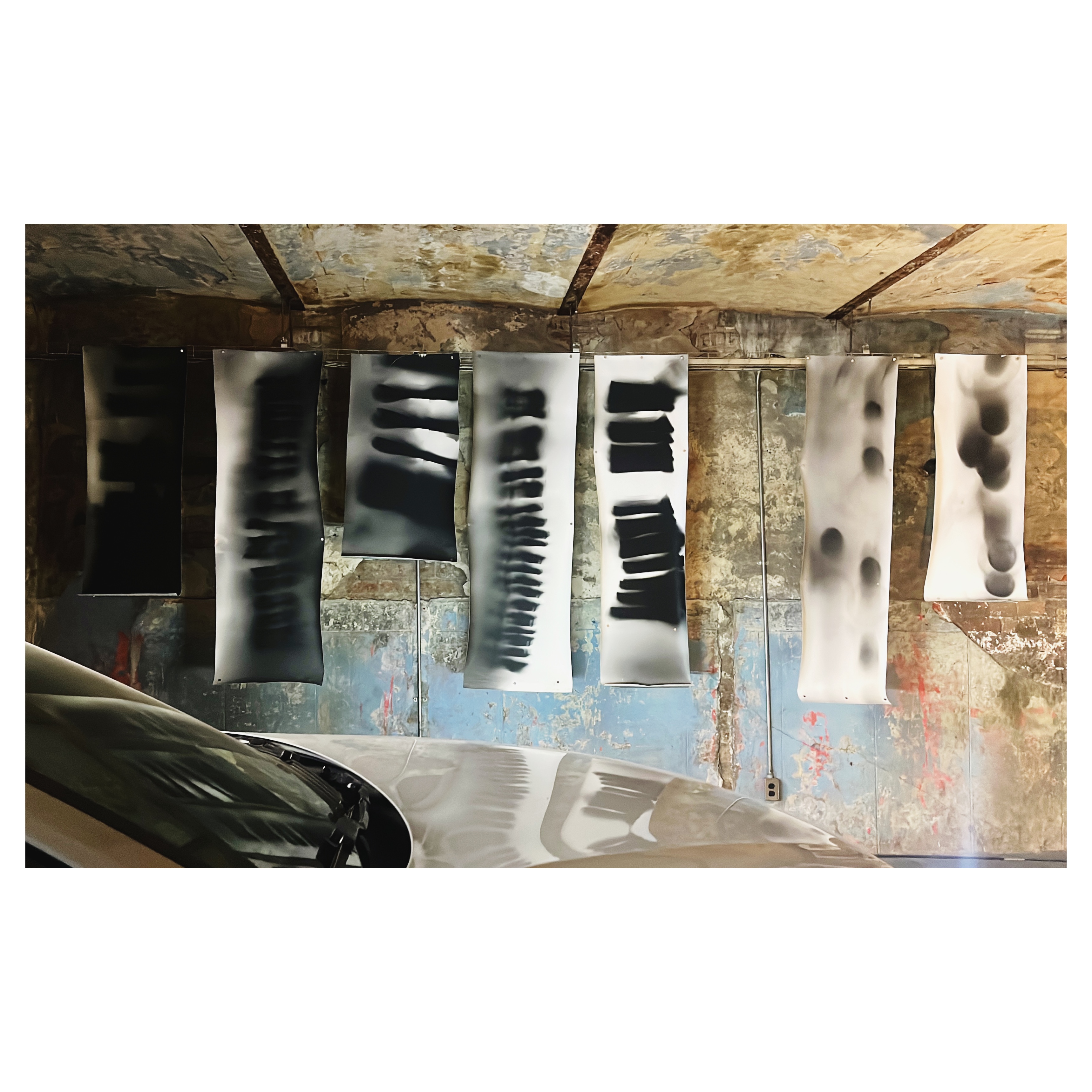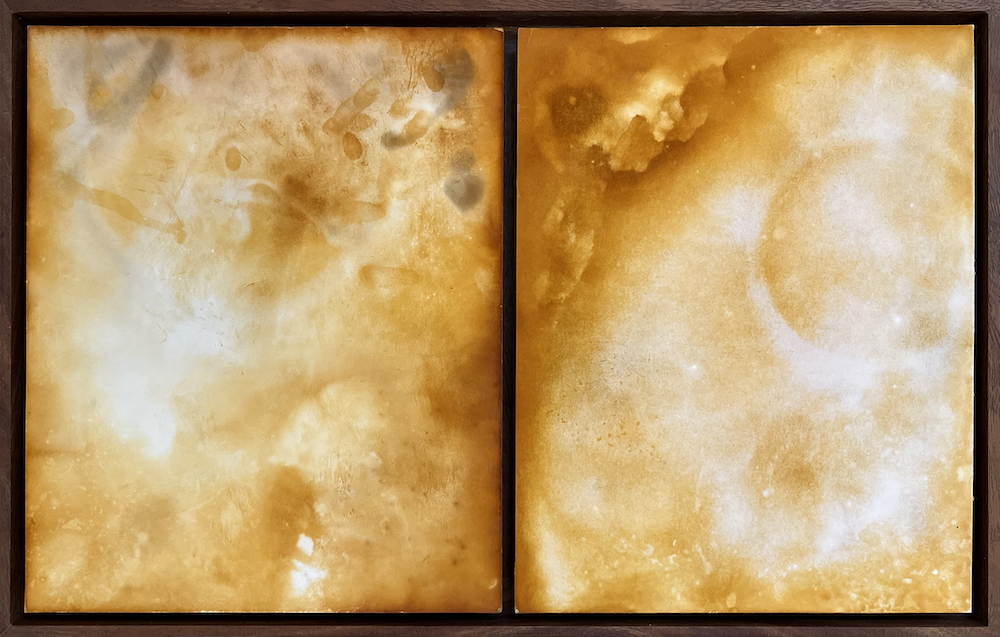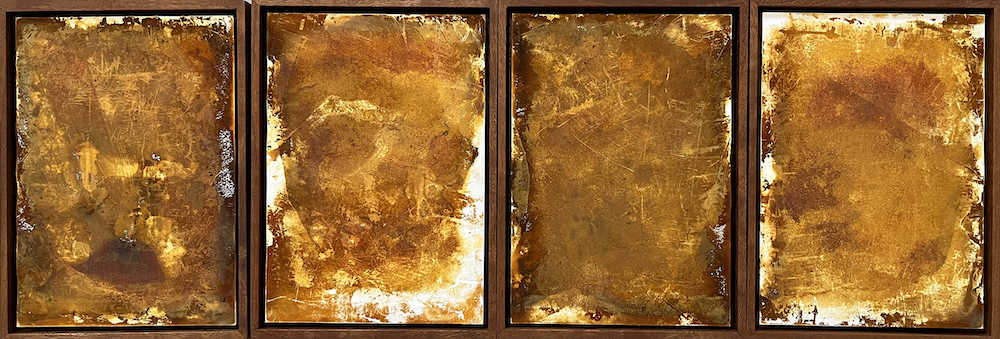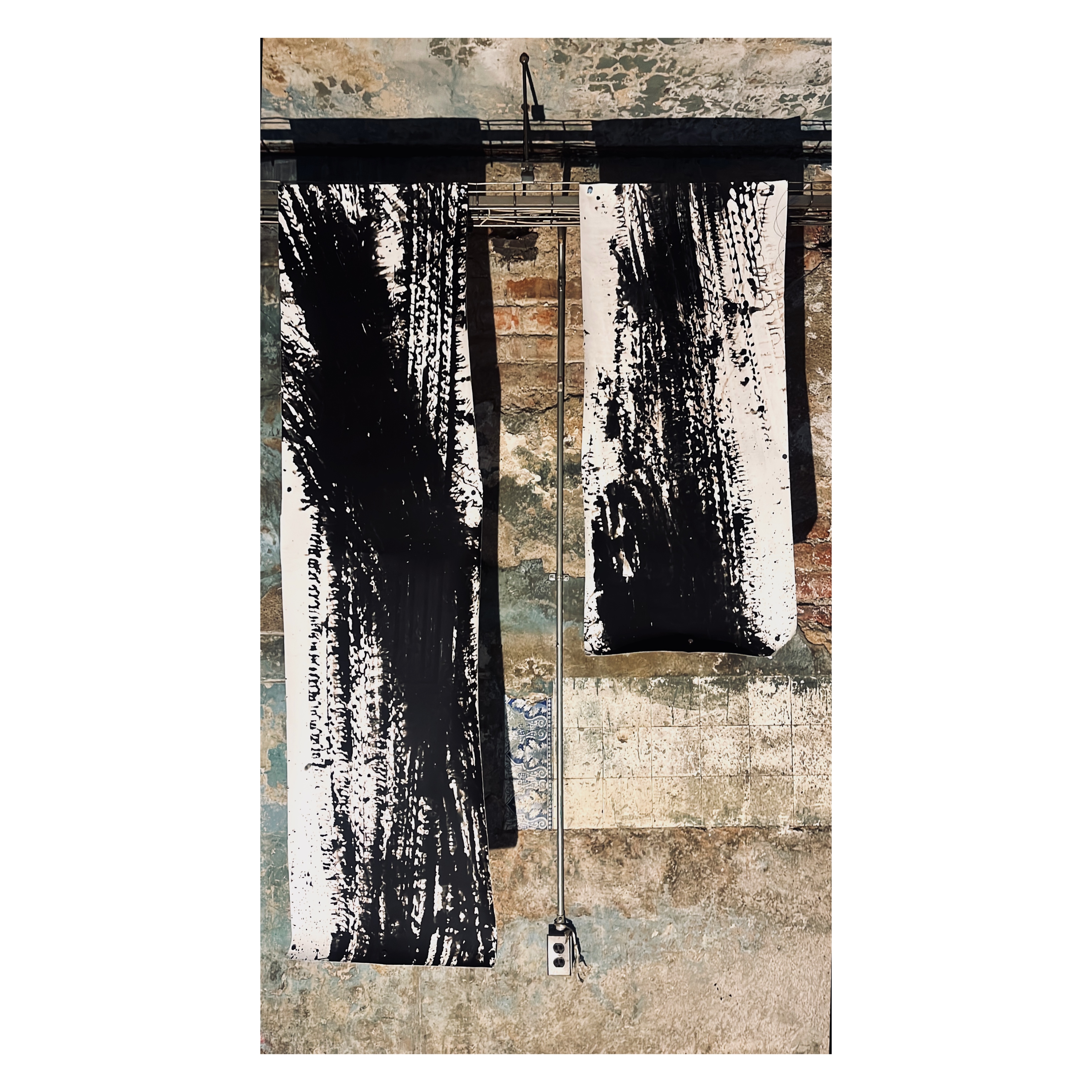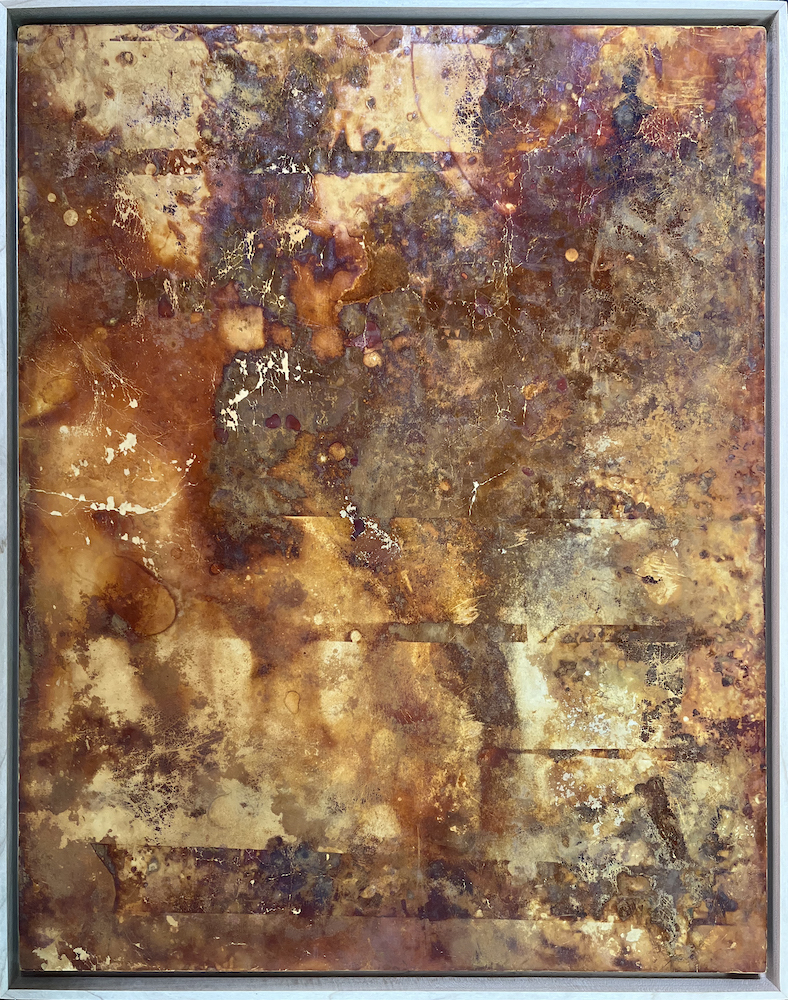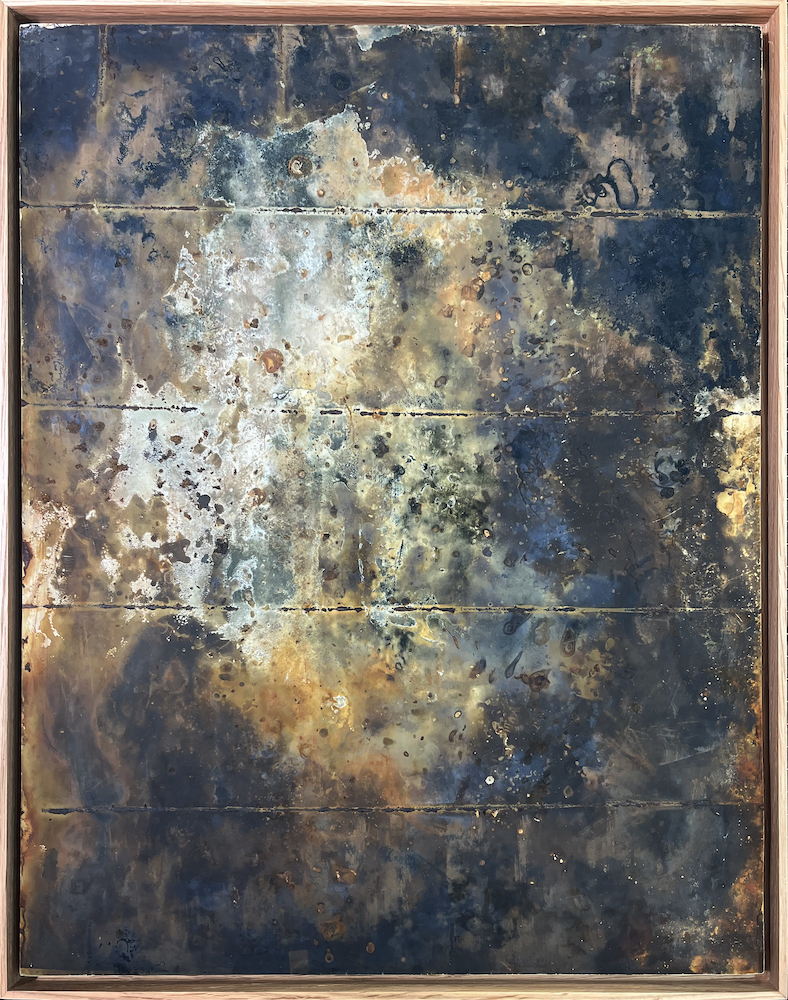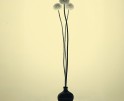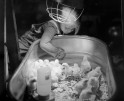Mexican Week Revisited: Margot Kalach — Part II
Margot Kalach’s solo exhibition at Salon ACME showcases her latest dive into camera-less photography. Using custom-made optical tools, her ethereal and hypnotic black and white light-drawings act as dynamic canvases for art, play, and science. On display until February 11, the exhibition also features an assortment of richly textured artworks crafted from oxides and residual photographic chemicals. The works are incredibly beautiful, simultaneously evoking visions of deserts, galaxies, bays, petri dishes, and the unreachable corners of the cosmos.
Salón ACME, launched in 2014, is an authentic art platform and event for emerging artists in Mexico and globally. With 10 editions, it’s a key player in the contemporary art scene, connecting artists, curators, and collectors.
In the second part of our part interview, the artist and I delve into the philosophical implications of light and photographic media, as well as her newest foray into works created with oxides from photographic residue.
—Vicente Isaías, Latin American Editor
Margot Kalach (Mexico City, 1992) holds a degree in photography from Bard College (2016). She attended the SOMA Mexico Academic Program (2017-2019). She was a recipient of the FONCA Young Creators scholarship (2019) and a resident at Casa Wabi (2021). She has a wide participation in group exhibitions, as well as three solo exhibitions: 08J3C71V17Y (Bard NY, 2016), The Dream of the Stone (Ex Convento Tepoztlán, 2021) and Reverberations (Cordoba Lab, Oaxaca, 2022). She has participated in fairs such as La Feria del Millón 2019 (Bogotá, Colombia) and PhotoLondon 2023 (London, UK).
Experimentation, play, and accident are an important foundation of the artist’s material universe. On a large scale, the projects seek to return subjectivity to the center of scientific models, mechanical systems, and the knowledge structures that are at the center of our daily lives today. Margot emphasizes intimate technologies, the organic and complex evolution of time and matter, and the philosophy and speculation of science as tools for creation.
Follow Margot Kalach on Instagram: @margotkalach
VC: Margot, congratulations on Salon Acme’s inauguration! Are there any artists at the exhibition whose works you would like to highlight?
MK: All of the artists present at Salon Acme are worth following, it is a fair with a very serious art proposal directed by curator Ana Castella, and all independent artists and galleries present are individuals that really put their heart in their work. The list of artists accepted into the section of individual artist open call by ACME has gathered a big group of young Mexican artists that, I believe, truly represent the very alive and effervescent scene of contemporary art in Mexico now. For photography lovers I would highlight the project of LATERAL presenting artist Andrea Martinez. I am also looking forward to the curatorial proposal by Abril Zales, who will focus on a group of artists from Nuevo Leon.
VC: Art and science. Photography seems a perfect medium to explore that intersection. What took you initially to the intersection of both?
MK: During my university years, I began studying the history of photography. Photography’s appearance coincided with a moment where art and science were largely integrated, and its appearance revolutionized both fields.
One would expect that these fields would grow more intertwined with their sharing of the photographic, but actually, the opposite began to happen. Art and science were thrown widely apart for the next couple of centuries under humanity’s obsession with objectivity, as the image played an essential role in the construction of science and truth. It is not until recently that art and science began to fuse again, with the image still at the center of discourse.
Did the rise of the observer’s paradox and our embracing of the uncertainty principle have something to do with the re-involvement of both fields? Maybe… But more simply, I think it was my encounter with light, through photography, that truly made me stop at this intersection.
Through light, we have access to both the visible and the invisible. I have come to understand light as the limit of our scientific knowledge while at the same time, the center of our metaphysical experience, recognizing both the limit and the center as expanding into each other.
The photon is the smallest, fastest unit of measurement in our scientific ruler; it brings us to the edge of space-time and black holes and delineates our physical possibilities. At the same time, enlightenment pushes outwards, sowing everything together into one, tying everything together transcendentally.
Photography, or what I understand as “the photographic moment” (a dynamic instant where subject, light, and mechanical tool synchronize in the search for meaning), is at the juncture of this realization.
VC: Given that your work involves “drawing with light,” how does your exploration of light as both a material and a concept contribute to the philosophical discourse surrounding perception, reality, and the limitations of human understanding?
MK: We cannot see light; light is invisible in itself. Does that mean that “we know light though that which it is not?”. Thoughts like this show how once you really start thinking about light, and using light, bouncing from a physical to a metaphysical plane and vice versa is inevitable. It is our perception about light that permits these magnificent jumps. We constantly think through our sensibility to light, and creating with light while thinking about light is a way of bringing myself to an infinite loop of reflection. The world reflecting itself to me, as I reflect myself on the world.
Light guides our thought, and our thought guides light.
Light is fundamentally uncertain and thinking is constantly ordering. Seeing and thinking about light is, consequently, observing and ordering through uncertainty. Are we constantly reaching certainty through uncertainty? So, understating thought light is both being illuminated and unsure, I cannot think of a more accurate description of what it feels to be alive. In a way light becomes both the limit and the main entrance. The limit becomes the point of departure, and uncertainty a force of creativity and revelation. We understand everything through limits, limits provide form, dimension, depth, organization, self.
Another important role of perception is finding beauty in the real. I feel inclined to appreciate art that is beautiful, not as decorative, or empty, but as inevitable. Light is unquestionably beautiful. What is the relationship between the beautiful and the true? Has our evolution as a species refined our perception to a point of finding beautiful that which is certain, so we find pleasure in analyzing and synthetizing it? Beauty is subjective, that is for sure, but I believe it is not arbitrary. It seems brighter when it lines up with a profound sense of knowing, even if that sense of knowing remains abstract.
VC: There is so much tension between our desire for order and the inherent chaos of reality. How do you see this influencing the thematic choices in your projects?
MK: I am unsure if the inherent state of reality is chaos, but I am sure of the human desire to continuously try to figure it out. We cannot help but try to make sense of things, to build and rebuild systems that tend towards understanding.
The ongoing transformation of this order, the constant paradigm shifts, the existence of paradox, all point to some sort of impossibility of the final form. Whether it is a technical problem, meaning our technology is not sophisticated enough, or a metaphysical one, the limits of our pre-programmed physiognomic capacities, we cannot ignore the existence of things that lay incomprehensible, unsaid.
Our consciousness of this blind spot, which feels blurry and constantly moving (echoing our vision of the elementary particles that build our universe), makes reality seem chaotic. Maybe reality is not chaotic in itself, but the contact that we make with it seems to organize itself chaotically, both scientifically chaotic (chaos theory) and emotionally chaotic (experience overflows overwhelmingly).
In my artistic process, I am interested in mirroring the experience of existing in this constant tension between order and disorder. For example, the tensions that rise in our capacity to create complex rational methods like quantum physics that lead us directly to the uncertainty principle. Or the tension of realizing that after centuries of refining rational systems, our sense of disorientation has just increased, as emotionally-bundled specs that float through an empty infinite void.
For the past years, I have been looking to construct the right conditions to simulate the most saturated version of this existential state, and the photographic moment has been a creative force field of revelation. To truly inhabit this moment, I have been concentrating on a process that focuses on the grand gesture that happens between a subject, their tool (the elaborate design and utilization of technology and science in search of order), and their contact with the material world (leading to a reality that is inevitably uncertain).
Time and time again, we move to try to grasp the essence of reality; yet, even after deepening methodically, something is always left unsaid of the complex and organic state of things, of the overflowing of life and matter. My work is a celebration of the technical and poetical action towards understanding, while simultaneously existing in the state of chaotic evolution (movement!).
Even if, as we perform, we know that at the core lies the impossibility of a final destination, we keep sensing and making sense. Exploring the world through the monumentalizing of the photographic act has brought me closest to a state of flooded existentiality, one centered around the tension that happens when a woman and a machine dive into the world, with light as simultaneously the guide and the main question.
VC: Your artistic process thrives on the uncertainty of the material, creating a conversation where you and the machine struggle to impose order. How does this uncertainty reflect broader philosophical themes in your work?
MK: From highly praised scientists to the common folk, uncertainty has permeated experience in such a way that it has become an intrinsic quality of reality. At the same time, we seem to be living in an unprecedented era of information. We are at the point where everything is information, yet our most rational structures lead to the fact that reality is fundamentally uncertain and paradoxical. Uncertainty basically defines our contemporary experience but coincides with humanity’s highest point of scientific and technological advances.
To me, light is the perfect impersonator of uncertainty. In the most technical and scientific way (as both light and particle), light remains a total mystery, fundamentally uncertain, yet so full of objective information that determines what is real. It is both full of information and also unsolvable. This adds a new level of paradox surrounding light and vision, as light reveals the world to us in such high resolution, but it does not necessarily reveal the truth (actually, the truth doesn’t even exist, apparently).
As the concepts of light (information), vision (organization), and truth arise, I touch upon ideas about the limits of our understanding, how we attempt to access what we don’t know, and how we organize what we do know. Many of the sciences’ “big questions” are big themes when thinking about my work—things like what the universe is made of, how life comes into being, how consciousness arises, is reality deterministic, what are the limits and the benefits of rational thought… To complicate things, our reason has led us to concepts like “post-truth,” “information paradox,” “incompleteness theory,” “uncertainty principle,” “artificial intelligence,” “infinite multiverses.” It is fascinating, it is terrifying, it is beautiful, it is absurd.
Focusing on these fundamental complications, paradoxes, contradictions, tensions has brought me to a photographic process in which I am constantly building an exaggeratedly technical-oriented universe that expresses itself emotionally, chaotically, irrationally. I am pushing for a light-based process that places the subject in a constant existential crossroad, navigating back and forth between certainty and uncertainty in order to reach a deep state of intuitive knowledge. As I perform in the dark, moving rhythmically yet chaotically, my tools push towards certainty. In the construction and transformation of the very raw materials of the physical world, I rediscover myself, my movements, through the traces of light. The movements reaffirm everything that we already knew but that surprises us every time.
VC: Margot, congratulations one more time. I have one last question for you. What led you to focus on bringing subjectivity back to the center of scientific models and knowledge structures, as seen in your artistic process?
MK: It is like we have forgot science is ourselves, and comes from deep inside ourselves. We are wired to be scientific, and artistic beings. Today we suddenly feel science is observing us from the outside, studying us, telling us what we are in a way that is closer to the truth than what we know about ourselves. Why do our most advances knowledge structures make us feel like we are moving farther away from what is most human?
In the history and search for objectivity the human hand became just invaluable noise. Mechanical and automatic accuracy came in to avoid mistakes, emotions were regarded as obstacles, people became numbers in the name of truth, but wait, didn’t you just say truth doesn’t exist? And if it does, at what cost, and the truth about what, and funded by who and why? As we navigate information towards deep understanding we cannot set aside intuition, personal experience, subjectivity…
I believe there is a big need to humanize scientific action and thought. I don´t believe that the search of a truth that erases us is of much benefit, if it is even possible. The construction of science remains one of the most special encounters with reality. The most beautiful thing about knowledge is that we contain it. Bringing the subject back into focus celebrates the mystery of life, the rise of consciousness, and the possibility to access information to care for the human condition.
Vicente Cayuela is a Chilean multimedia artist working primarily in research-based, staged photographic projects. Inspired by oral history, the aesthetics of picture riddle books, and political propaganda, his complex still lifes and tableaux arrangements seek to familiarize young audiences with his country’s history of political violence. His 2022 debut series “JUVENILIA” earned him an Emerging Artist Award in Visual Arts from the Saint Botolph Club Foundation, a Lenscratch Student Prize, an Atlanta Celebrates Photography Equity Scholarship, and a photography jurying position at the 2023 Alliance for Young Artists & Writers’ Scholastic Art and Writing Awards in the Massachusetts region. His work has been exhibited most notably at the Griffin Museum of Photography, Abigail Ogilvy Gallery, PhotoPlace Gallery, and published nationally and internationally in print and digital publications. A cultural worker, he has interviewed renowned artists and curators and directed several multimedia projects across various museum platforms and art publications. He is currently a content editor at Lenscratch Photography Daily and Lead Content Creator at the Griffin Museum of Photography. He holds a BA in Studio Art from Brandeis University, where he received a Deborah Josepha Cohen Memorial Award in Fine Arts and a Susan Mae Green Award for Creativity in Photography.
Follow Vicente Cayuela on Instagram: @vicente.isaias.art
Posts on Lenscratch may not be reproduced without the permission of the Lenscratch staff and the photographer.
Recommended
-
Scott Offen: GraceDecember 12th, 2025
-
Izabella Demavlys: Without A Face | Richards Family PrizeDecember 11th, 2025
-
2025 What I’m Thankful For Exhibition: Part 2November 27th, 2025
-
2025 What I’m Thankful For Exhibition: Part 3November 27th, 2025
-
2025 What I’m Thankful For Exhibition: Part 4November 27th, 2025


